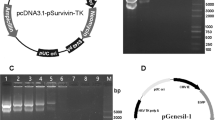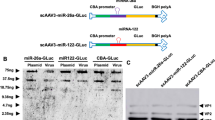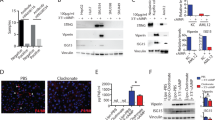Abstract
Ideal cancer gene therapies should have high tumor specificity and efficacy, and allow systemic administration to target metastases. We recently developed a bi-directional, two-step transcriptional amplification (TSTA) system driven by the tumor-specific Survivin promoter (pSurv) to amplify the correlated expression of both the reporter gene firefly luciferase (FL) and therapeutic gene tumor necrosis factor-related apoptosis-inducing ligand (TRAIL). Here, we compare the specificity and potency of an adenovirus carrying this system (Ad-pSurv-TSTA-TRAIL-FL) to a nonspecific vector (Ad-pCMV-FL) in an orthotopic hepatocellular carcinoma (HCC) rat model after systemic administration. At 24 h after injection of Ad-pCMV-FL, bioluminescence imaging revealed a trend (P=0.30) towards greater FL expression in liver versus tumor. In striking contrast, Ad-pSurv-TSTA-TRAIL-FL showed increased FL activity within the tumor compared with the liver (P<0.01), a strong trend towards reduced liver expression compared with Ad-pCMV-FL (P=0.07), and importantly, similar FL levels within tumor compared with Ad-pCMV-FL (P=0.32). Hence, this vector shows potent, tumor-specific transgene expression even after extensive liver transduction and may be of significant value in avoiding hepatotoxicity in HCC patients. Future studies will explore the benefits of tumor-specific TRAIL expression in this model, the potential to target metastases and the extension of this vector for the treatment of other Survivin-positive tumors is warranted.
This is a preview of subscription content, access via your institution
Access options
Subscribe to this journal
Receive 12 print issues and online access
$259.00 per year
only $21.58 per issue
Buy this article
- Purchase on Springer Link
- Instant access to full article PDF
Prices may be subject to local taxes which are calculated during checkout






Similar content being viewed by others
References
Akiyama M, Thorne S, Kirn D, Roelvink PW, Einfeld DA, King CR et al. Ablating CAR and integrin binding in adenovirus vectors reduces nontarget organ transduction and permits sustained bloodstream persistence following intraperitoneal administration. Mol Ther 2004; 9: 218–230.
Lo H-W, Day C-P, Hung M-C . Cancer-specific gene therapy. Adv Genet 2005; 54: 235–255.
Iyer M, Wu L, Carey M, Wang Y, Smallwood A, Gambhir SS . Two-step transcriptional amplification as a method for imaging reporter gene expression using weak promoters. Proc Natl Acad Sci USA 2001; 98: 14595–14600.
Zhang L, Adams JY, Billick E, Ilagan R, Iyer M, Le K et al. Molecular engineering of a two-step transcription amplification (TSTA) system for transgene delivery in prostate cancer. Mol Ther 2002; 5: 223–232.
Ray S, Paulmurugan R, Patel MR, Ahn BC, Wu L, Carey M et al. Noninvasive imaging of therapeutic gene expression using a bidirectional transcriptional amplification strategy. Mol Ther 2008; 16: 1848–1856.
Gambhir SS, Herschman HR, Cherry SR, Barrio JR, Satyamurthy N, Toyokuni T et al. Imaging transgene expression with radionuclide imaging technologies. Neoplasia 2000; 2: 118–138.
Ray S, Paulmurugan R, Hildebrandt I, Iyer M, Wu L, Carey M et al. Novel bidirectional vector strategy for amplification of therapeutic and reporter gene expression. Hum Gene Ther 2004; 15: 681–690.
Van den Bosch JJ, Higgins L, Hwang G, Katzenberg RH, Willmann JK, Paulmurugan R et al. Novel rat hepatocellular carcinoma model designed for in vivo evaluation of image-guided therapies. J Vasc Interv Radiol 2008; 19: S136.
El-Serag HB, Rudolph KL . Hepatocellular carcinoma: epidemiology and molecular carcinogenesis. Gastroenterology 2007; 132: 2557–2576.
Blum HE . Hepatocellular carcinoma: therapy and prevention. World J Gastroenterol 2005; 11: 7391–7400.
LeBlanc HN, Ashkenazi A . Apo2L/TRAIL and its death and decoy receptors. Cell Death Differ 2003; 10: 66–75.
Vorburger SA, Hunt KK . Adenoviral gene therapy. Oncologist 2002; 7: 46–59.
Nakaya H, Ishizu A, Ikeda H, Tahara M, Shindo J, Itoh R et al. In vitro model of suicide gene therapy for alpha-fetoprotein-producing gastric cancer. Anticancer Res 2003; 23: 3795–3800.
Ye X, Liang M, Meng X, Ren X, Chen H, Li Z-Y et al. Insulation from viral transcriptional regulatory elements enables improvement to hepatoma-specific gene expression from adenovirus vectors. Biochem Biophys Res Commun 2003; 307: 759–764.
Zhang M, Li S, Nyati MK, DeRemer S, Parsels J, Rehemtulla A et al. Regional delivery and selective expression of a high-activity yeast cytosine deaminase in an intrahepatic colon cancer model. Cancer Res 2003; 63: 658–663.
Anderson LM, Krotz S, Weitzman SA, Thimmapaya B . Breast cancer-specific expression of the Candida albicans cytosine deaminase gene using a transcriptional targeting approach. Cancer Gene Ther 2000; 7: 845–852.
Bilsland AE, Anderson CJ, Fletcher-Monaghan AJ, McGregor F, Evans TRJ, Ganly I et al. Selective ablation of human cancer cells by telomerase-specific adenoviral suicide gene therapy vectors expressing bacterial nitroreductase. Oncogene 2003; 22: 370–380.
Katz MH, Spivack DE, Takimoto S, Fang B, Burton DW, Moossa AR et al. Gene therapy of pancreatic cancer with green fluorescent protein and tumor necrosis factor-related apoptosis-inducing ligand fusion gene expression driven by a human telomerase reverse transcriptase promoter. Ann Surg Oncol 2003; 10: 762–772.
Iyer M, Salazar FB, Lewis X, Zhang L, Carey M, Wu L et al. Noninvasive imaging of enhanced prostate-specific gene expression using a two-step transcriptional amplification-based lentivirus vector. Mol Ther 2004; 10: 545–552.
Iyer M, Salazar FB, Lewis X, Zhang L, Wu L, Carey M et al. Non-invasive imaging of a transgenic mouse model using a prostate-specific two-step transcriptional amplification strategy. Transgenic Res 2005; 14: 47–55.
Iyer M, Salazar FB, Wu L, Carey M, Gambhir SS . Bioluminescence imaging of systemic tumor targeting using a prostate-specific lentiviral vector. Hum Gene Ther 2006; 17: 125–132.
Wang Y, Iyer M, Annala A, Wu L, Carey M, Gambhir SS . Noninvasive indirect imaging of vascular endothelial growth factor gene expression using bioluminescence imaging in living transgenic mice. Physiol Genomics 2006; 24: 173–180.
Huyn ST, Burton JB, Sato M, Carey M, Gambhir SS, Wu L . A potent, imaging adenoviral vector driven by the cancer-selective mucin-1 promoter that targets breast cancer metastasis. Clin Cancer Res 2009; 15: 3126–3134.
Ito T, Shiraki K, Sugimoto K, Yamanaka T, Fujikawa K, Ito M et al. Survivin promotes cell proliferation in human hepatocellular carcinoma. Hepatology 2000; 31: 1080–1085.
Lu B, Makhija SK, Nettelbeck DM, Rivera AA, Wang M, Komarova S et al. Evaluation of tumor-specific promoter activities in melanoma. Gene Ther 2005; 12: 330–338.
Altieri DC . Validating survivin as a cancer therapeutic target. Nat Rev Cancer 2003; 3: 46–54.
Chen J-S, Liu J-C, Shen L, Rau K-M, Kuo H-P, Li YM et al. Cancer-specific activation of the survivin promoter and its potential use in gene therapy. Cancer Gene Ther 2004; 11: 740–747.
Chen W-C, Liu Q, Fu J-X, Kang S-Y . Expression of survivin and its significance in colorectal cancer. World J Gastroenterol 2004; 10: 2886–2889.
Li B, Liu X, Fan J, Qi R, Bo L, Gu J et al. A survivin-mediated oncolytic adenovirus induces non-apoptotic cell death in lung cancer cells and shows antitumoral potential in vivo. J Gene Med 2006; 8: 1232–1242.
Van Houdt WJ, Haviv YS, Lu B, Wang M, Rivera AA, Ulasov IV et al. The human survivin promoter: a novel transcriptional targeting strategy for treatment of glioma. J Neurosurg 2006; 104: 583–592.
Zhu ZB, Makhija SK, Lu B, Wang M, Rivera AA, Kim-Park S et al. Incorporating the survivin promoter in an infectivity enhanced CRAd-analysis of oncolysis and anti-tumor effects in vitro and in vivo. Int J Oncol 2005; 27: 237–246.
Oikonomou E, Kothonidis K, Taoufik E, Probert E, Zografos G, Nasioulas G et al. Newly established tumourigenic primary human colon cancer cell lines are sensitive to TRAIL-induced apoptosis in vitro and in vivo. Br J Cancer 2007; 97: 73–84.
Ashkenazi A, Pai RC, Fong S, Leung S, Lawrence DA, Marsters SA et al. Safety and antitumor activity of recombinant soluble Apo2 ligand. J Clin Invest 1999; 104: 155–162.
Kelley SK, Harris LA, Xie D, Deforge L, Totpal K, Bussiere J et al. Preclinical studies to predict the disposition of Apo2L/tumor necrosis factor-related apoptosis-inducing ligand in humans: characterization of in vivo efficacy, pharmacokinetics, and safety. J Pharmacol Exp Ther 2001; 299: 31–38.
Griffith TS, Anderson RD, Davidson BL, Williams RD, Ratliff TL . Adenoviral-mediated transfer of the TNF-related apoptosis-inducing ligand/Apo-2 ligand gene induces tumor cell apoptosis. J Immunol 2000; 165: 2886–2894.
Kagawa S, He C, Gu J, Koch P, Rha SJ, Roth JA et al. Antitumor activity and bystander effects of the tumor necrosis factor-related apoptosis-inducing ligand (TRAIL) gene. Cancer Res 2001; 61: 3330–3338.
Wu GS . TRAIL as a target in anti-cancer therapy. Cancer Lett 2009; 285: 1–5.
Holoch PA, Griffith TS . TNF-related apoptosis-inducing ligand (TRAIL): a new path to anti-cancer therapies. Eur J Pharmacol 2009; 625: 63–72.
Armeanu S, Lauer UM, Smirnow I, Schenk M, Weiss TS, Gregor M et al. Adenoviral gene transfer of tumor necrosis factor-related apoptosis-inducing ligand overcomes an impaired response of hepatoma cells but causes severe apoptosis in primary human hepatocytes. Cancer Res 2003; 63: 2369–2372.
Niu G, Gaut AW, Ponto LLB, Hichwa RD, Madsen MT, Graham MM et al. Multimodality noninvasive imaging of gene transfer using the human sodium iodide symporter. J Nucl Med 2004; 45: 445–449.
Ray P, Tsien R, Gambhir SS . Construction and validation of improved triple fusion reporter gene vectors for molecular imaging of living subjects. Cancer Res 2007; 67: 3085–3093.
Acknowledgements
We would like to acknowledge grant support from NCI ICMIC P50CA114747 (SSG) and NCI RO1 CA082214 (SSG). We would also like to thank Tim Doyle (Stanford Center for Innovation in In Vivo Imaging, Stanford University) for help with small animal imaging. JAR is supported by the Canadian Institutes of Health Research Postdoctoral Fellowship. B-CA received financial support from the Nuclear Infra Construction of Nuclear R&D program, Korean ministry of Science and Technology.
Author information
Authors and Affiliations
Corresponding author
Ethics declarations
Competing interests
The authors declare no conflict of interest.
Rights and permissions
About this article
Cite this article
Ahn, BC., Ronald, J., Kim, Y. et al. Potent, tumor-specific gene expression in an orthotopic hepatoma rat model using a Survivin-targeted, amplifiable adenoviral vector. Gene Ther 18, 606–612 (2011). https://doi.org/10.1038/gt.2011.5
Received:
Revised:
Accepted:
Published:
Issue Date:
DOI: https://doi.org/10.1038/gt.2011.5
Keywords
This article is cited by
-
Targeting of phage particles towards endothelial cells by antibodies selected through a multi-parameter selection strategy
Scientific Reports (2017)
-
MicroRNA-regulated non-viral vectors with improved tumor specificity in an orthotopic rat model of hepatocellular carcinoma
Gene Therapy (2013)
-
Optical Imaging for Stem Cell Differentiation to Neuronal Lineage
Nuclear Medicine and Molecular Imaging (2012)
-
Assessment of an altered E1B promoter on the specificity and potency of triple-regulated conditionally replicating adenoviruses: implications for the generation of ideal m-CRAs
Cancer Gene Therapy (2011)



